Dark colors, dramatic lighting, and unexpected finishes can completely redefine how a powder room feels. Instead of playing it safe with neutrals, moody aesthetics invite a bold and memorable experience in a small but high-impact space. Whether it’s deep navy walls, matte black fixtures, or dramatic wallpaper, the right design elements can turn a simple half-bath into a conversation starter. These ideas cater to homeowners looking to take design risks in contained spaces—where creativity meets function without overwhelming the rest of the home. This post showcases inspiring moody powder room concepts that blend character, contrast, and sophistication in clever ways.
Color-Drenched Walls
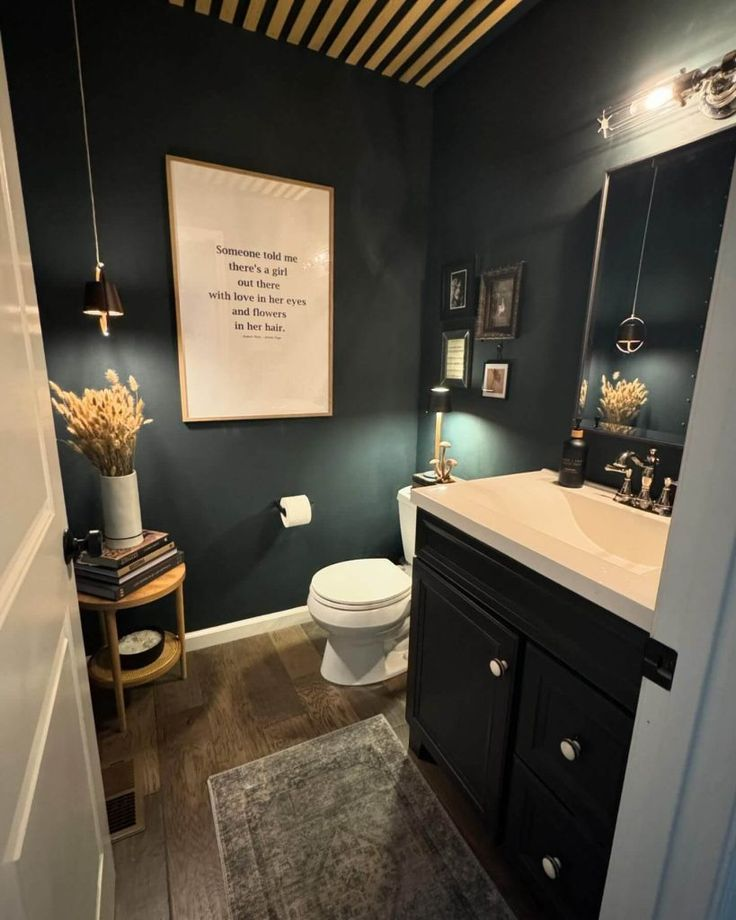
Dark, saturated colors set an unmistakably dramatic tone in a moody powder room. Opting for rich hues like charcoal, forest green, or midnight blue envelopes the space in warmth and depth, especially when paired with low lighting and matte finishes. This technique makes even small bathrooms feel intentional rather than confined. When used floor-to-ceiling, these colors create a cocooning effect, ideal for intimate environments. Matte paint enhances the velvety richness, while high-gloss variations add reflective contrast. Wall-to-wall color also serves as a perfect backdrop for metallic or antique decor elements, which pop in contrast. Whether modern or vintage-inspired, dark tones act as a blank canvas that amplifies design elements without overwhelming the senses. This approach also simplifies decor decisions, allowing statement pieces to shine effortlessly. Color-drenched walls don’t just add visual impact—they invite users into a space that feels immersive, luxurious, and entirely distinct from the rest of the home.
Vintage-Inspired Fixtures
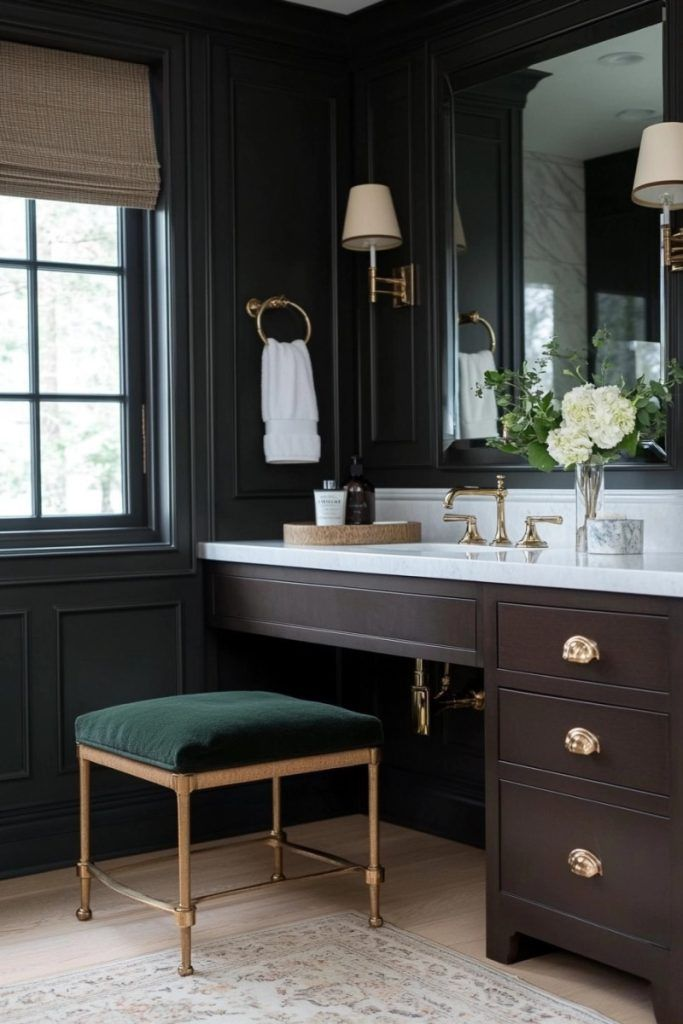
Classic hardware brings old-world charm into a powder room with ease. Selecting aged brass or oil-rubbed bronze finishes immediately evokes a sense of history, especially when used on faucets, sconces, and towel rings. Look for cross-handle taps, curved spouts, and porcelain details to add authenticity. Period-inspired lighting, such as fluted glass or candle-style wall sconces, complements the look beautifully while maintaining functionality. Pairing these fixtures with dark-painted walls enhances their patina and presence. While modern bathrooms often favor clean lines and minimalism, vintage elements feel curated and storied. They also bridge design eras, working seamlessly with bold wallpapers or textured treatments. A pedestal sink or exposed plumbing in aged metal reinforces this mood and deepens the nostalgic aesthetic. Vintage-inspired details don’t just nod to the past—they ground the space in a timeless atmosphere that feels both elegant and approachable, especially in moody, character-rich powder room designs.
Textured Wall Treatments
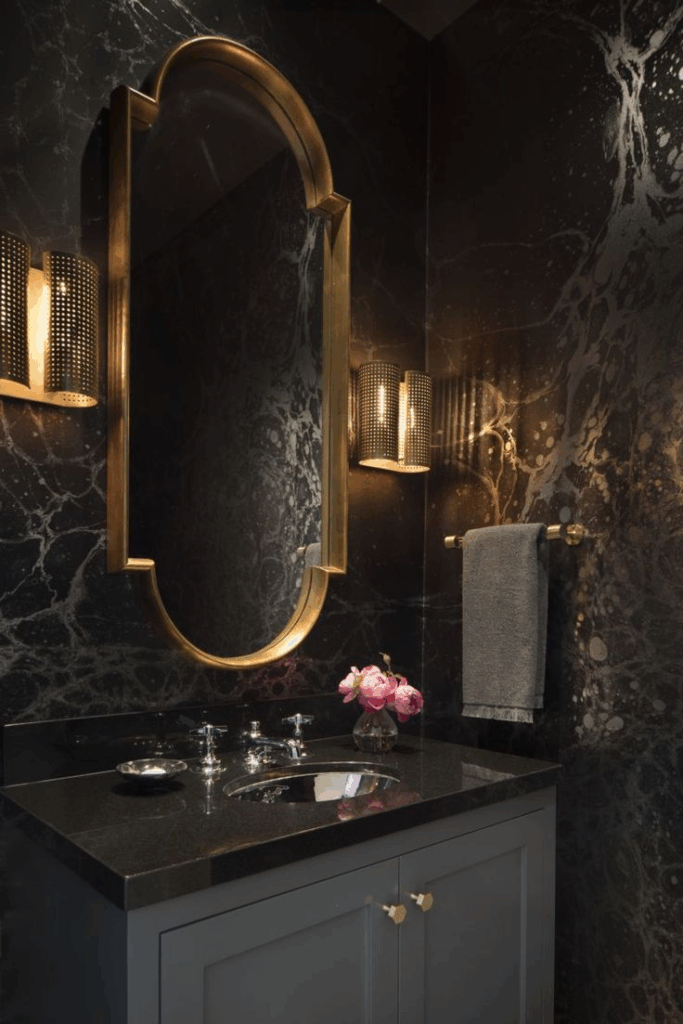
Dim lighting and tactile surfaces go hand in hand in cultivating mood. Incorporating wall textures like limewash, Venetian plaster, or brushed concrete instantly adds depth and visual interest. These finishes catch and diffuse light uniquely, giving walls an organic, lived-in quality that flat paint can’t match. In smaller powder rooms, texture acts as a design element that doesn’t require extra decor. Even subtle treatments like beadboard, tongue-and-groove, or textured wallpaper elevate the aesthetic without overwhelming the space. Dark tones paired with natural textures such as wood paneling or burlap wallpaper can balance moody with grounded. For a luxe edge, metallic or embossed finishes offer understated drama. These surfaces not only mask minor wall imperfections but also reflect design thoughtfulness. Using wall texture as part of your moody scheme makes the room feel bespoke and deliberate—ideal for turning an overlooked space into a design-forward statement.
Statement Lighting
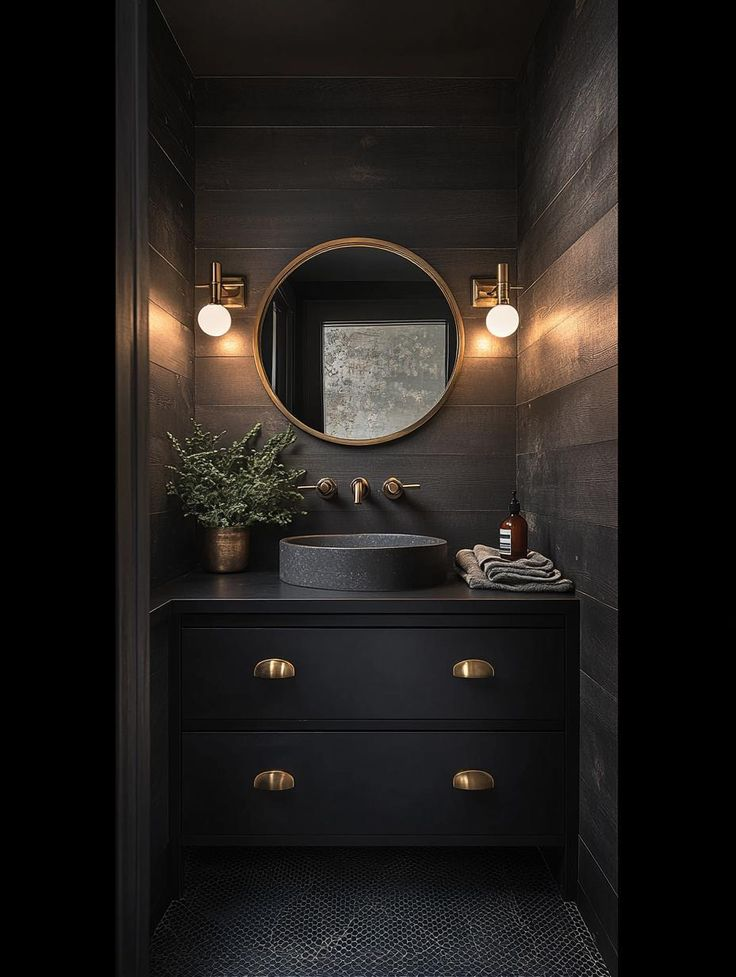
Light fixtures act as jewelry in a moody powder room, so choosing the right one can shift the atmosphere entirely. Think sculptural pendants, smoky glass sconces, or moody brass chandeliers—fixtures that double as art and ambient light sources. Rather than relying on bright overhead lighting, focus on lower, warmer tones that highlight wall treatments, reflect in metallic finishes, and cast intentional shadows. Even a single dimmable pendant above a mirror can provide enough light while preserving the mysterious, inviting vibe. Industrial cage lights, globe bulbs with antique filaments, or dramatic shaded sconces work beautifully against dark walls. Positioning is crucial—flanking the mirror or mounted off-center above an art piece adds visual balance. For a powder room with limited square footage, lighting becomes the focal point. Prioritizing ambiance over brightness makes the space feel curated, luxurious, and distinct from utilitarian bath lighting found elsewhere in the home.
Bold Wallpaper
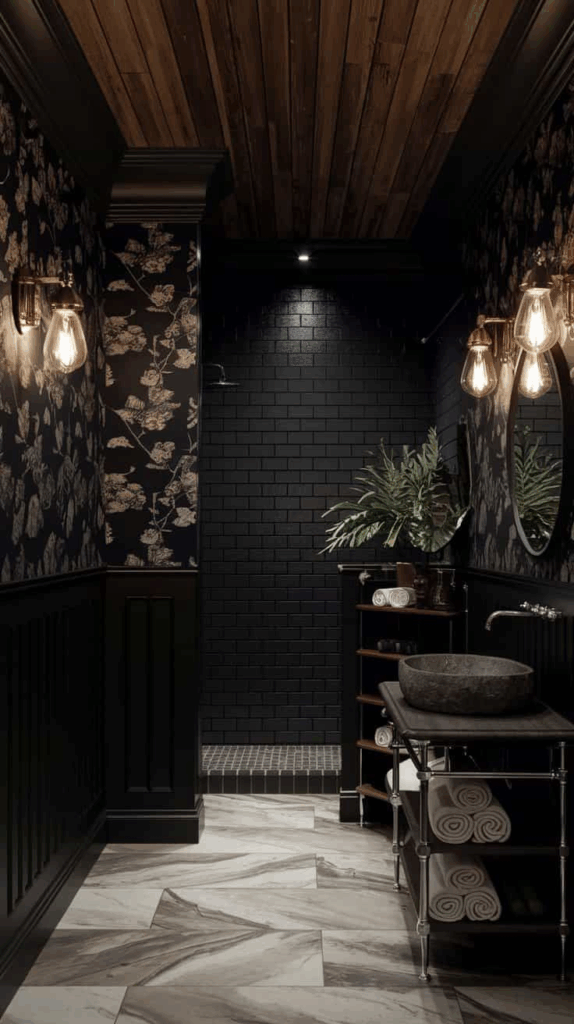
Moody powder rooms thrive on drama, and wallpaper provides an instant path to visual impact. Large-scale florals, metallic botanicals, or abstract patterns layered over dark backgrounds add dimension and artistry. With limited square footage, wallpaper becomes a primary statement rather than an accent. Look for matte finishes or subtle sheen to play with ambient light, and consider pairing it with molding or wainscoting for structure. A monochromatic print in deep tones adds texture without competing with fixtures. Alternatively, murals or panoramic designs can make a small space feel enveloping and immersive. Wallpaper also offers the flexibility to match themes—from Art Deco glamour to moody romanticism—while allowing creativity to flourish. Since powder rooms see less humidity, wallpaper remains a practical yet expressive option. Using it strategically enhances personality and elevates the experience beyond basic functionality, turning this often-forgotten room into a standout moment in the home.
Floating Vanities

Airy in appearance yet grounded in style, floating vanities help moody powder rooms maintain both function and form. By lifting cabinetry off the floor, these vanities create a sense of space even in tight layouts while allowing underglow lighting to add ambiance. Deep wood tones, matte finishes, or stone countertops pair beautifully with moody palettes. Wall-mounted designs keep the focus on materials and streamline the visual flow. Opting for slab fronts or minimalist hardware ensures that the vanity doesn’t overpower darker walls or bold wallpapers. Open shelf variations can also accommodate baskets or decorative storage, blending utility with style. Paired with vessel sinks or sculptural basins, these vanities become art pieces in themselves. The floating style aligns with both contemporary and transitional aesthetics, proving that small bathrooms don’t need to sacrifice design for practicality. Instead, they become refined, elevated spaces grounded in thoughtful design.
Ambient Lighting
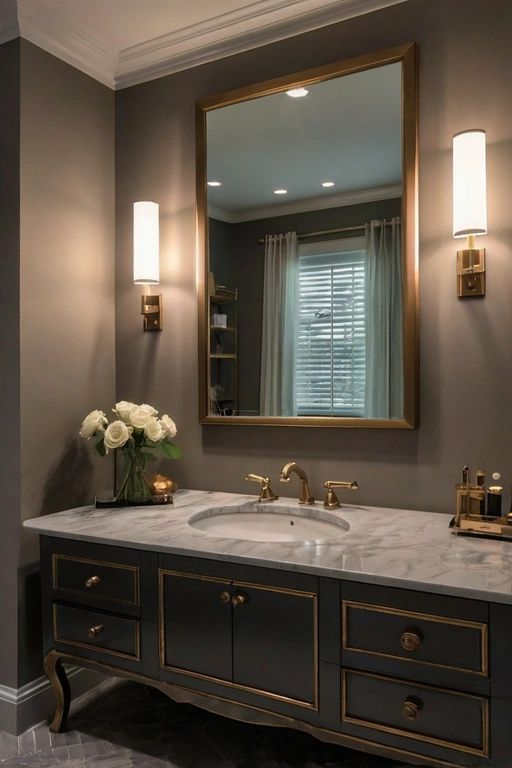
Subtle lighting plays a critical role in defining mood. Instead of relying on harsh ceiling lights, aim for layered sources that cast a soft glow across surfaces. Wall sconces with dimmers, under-vanity LED strips, or candlelight alternatives work beautifully in creating atmosphere. The goal is to highlight finishes without overexposing them, allowing textures and shadows to interplay naturally. Even low-wattage bulbs with warm color temperatures enhance the inviting quality of a moody palette. Consider concealed lighting behind mirrors or above crown molding for a floating effect. These techniques avoid starkness and contribute to a sense of intimacy—especially effective in small powder rooms. Ambient lighting also complements other bold features, allowing them to stand out without overpowering. When executed correctly, it turns the space into an experience rather than a mere utility room. Prioritizing softness and directionality ensures that the mood feels intentional, elegant, and lasting.
Natural Elements
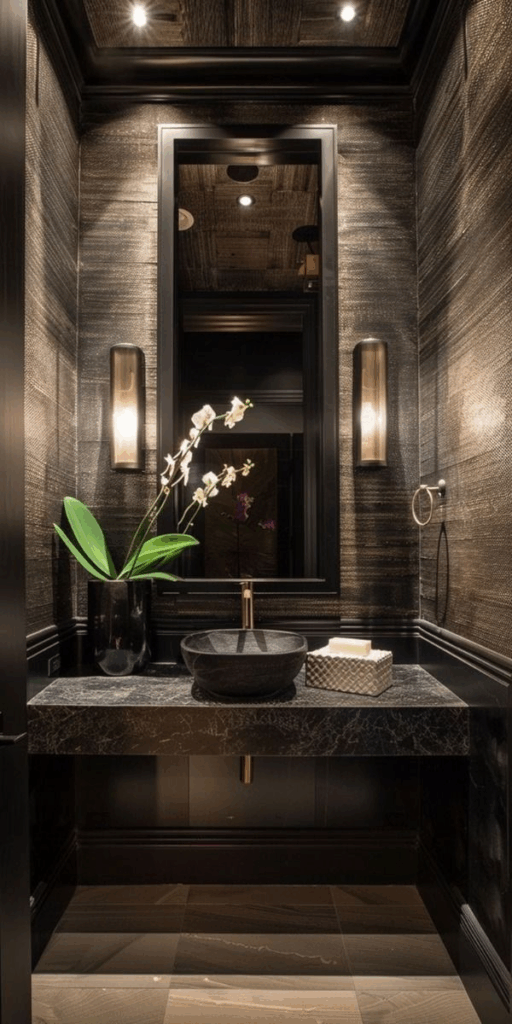
Earthy textures and organic finishes bring warmth into even the darkest powder rooms. Think natural stone sinks, reclaimed wood vanities, or raw-edge countertops to contrast deeper wall tones. Greenery in small doses—like eucalyptus stems or hanging ivy—softens the visual weight of moody palettes. Materials like rattan baskets, linen hand towels, or pebbled floors add tactile depth and subtle contrast. These organic touches keep the room from feeling too stark or artificial, especially when paired with matte finishes. Integrating live-edge mirrors, river rock tiles, or bamboo shelving introduces balance without diminishing the drama. Even dark spaces benefit from nature-inspired details, which calm the intensity and evoke spa-like tranquility. Incorporating these elements makes the room feel grounded and layered, appealing to the senses and enhancing the overall atmosphere. In spaces where light is intentionally limited, natural materials offer contrast that feels intentional, timeless, and restorative.
Artistic Mirrors
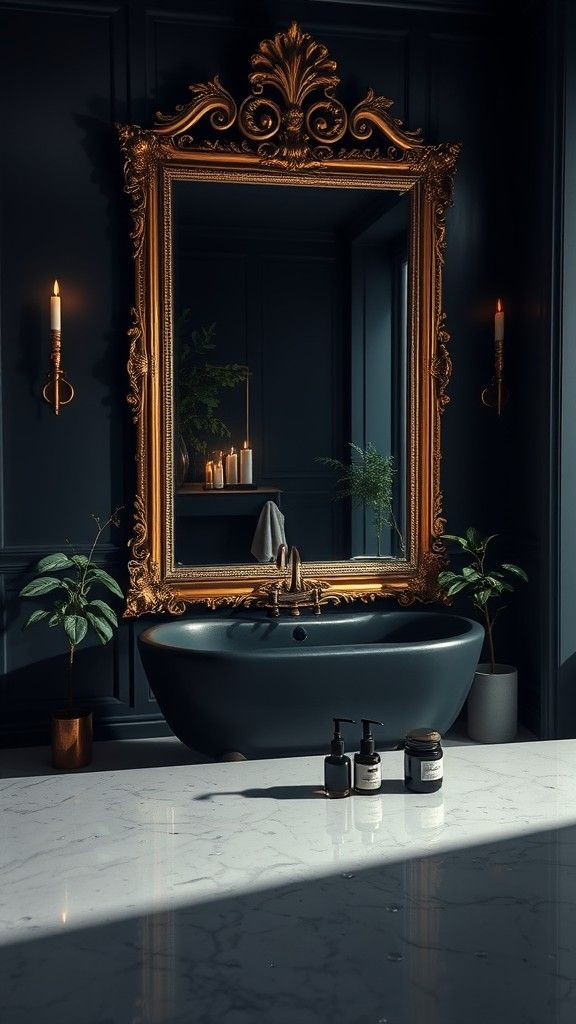
Unconventional mirrors act as sculptural focal points while reflecting just enough light to keep a moody powder room from feeling enclosed. Ornate frames, asymmetrical shapes, or antique finishes make these pieces more than functional—they become design statements. Round or oval silhouettes soften angular lines, while abstract mirrors enhance contemporary themes. Choosing bronze, blackened metal, or distressed gold finishes adds texture and complements shadowed tones. Placement is key; aligning mirrors opposite a pendant light or textured wall treatment can multiply the room’s depth visually. Backlit mirrors offer added ambiance without disrupting the design’s tone. Framing them in unexpected materials like stone, leather, or wood reinforces the curated aesthetic. By blending artistry with utility, the mirror transforms into an anchor for the space—reflecting style, intention, and mood in equal measure. In compact powder rooms, this one choice often determines the entire design narrative.
Layered Textiles
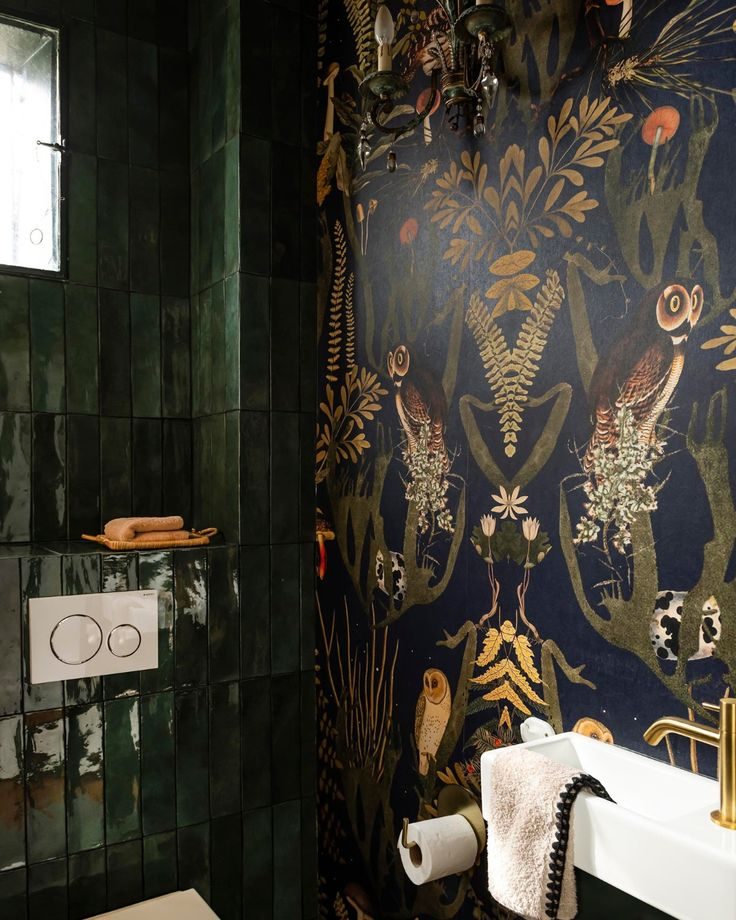
Soft materials contribute unexpected richness in a space often dominated by hard finishes. Layering textiles in a moody powder room involves more than a single towel—it means mixing materials and patterns in thoughtful, restrained ways. Hand towels with tassels, patterned curtains over frosted windows, or a small area rug with vintage flair can warm up the atmosphere. Stick to deeper hues or muted patterns to keep cohesion with the overall palette. Velvet or linen textures introduce a tactile element that balances stone or tile. Even unexpected additions like a draped stool or framed fabric panel elevate the space. These layers bring comfort and visual interest, especially when light interacts with the surfaces. In small areas, these details feel intentional and curated. By incorporating a few well-placed textiles, the room gains a sense of depth and lived-in luxury—proving that softness has its rightful place in even the boldest powder rooms.
Monochromatic Schemes
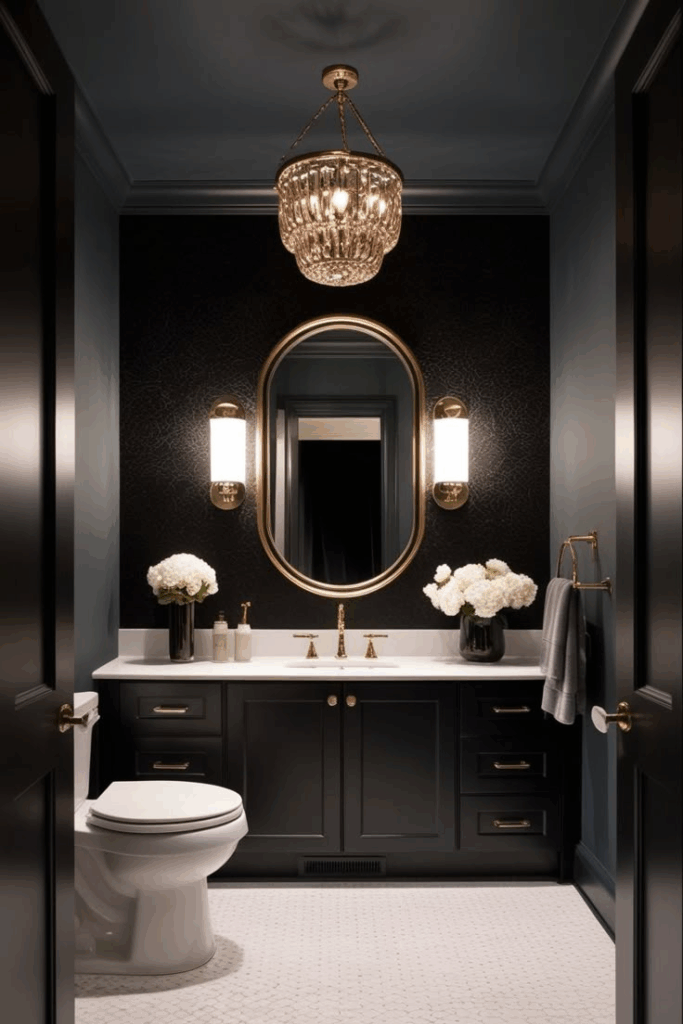
Staying within a single color family produces a cohesive, immersive feel that works beautifully in moody powder rooms. Using different tones, textures, and finishes of one hue—such as slate, charcoal, or merlot—prevents the space from feeling flat while enhancing depth. Glossy tile against matte walls or brushed metal against lacquered cabinetry keeps the eye engaged. A monochrome palette also allows room for sculptural elements, like bold lighting or ornate hardware, to shine without visual chaos. Working within a single hue simplifies decision-making while creating a polished final result. This technique works particularly well in small bathrooms where too many colors could feel cluttered. Keeping continuity from wall treatments to flooring ensures the design feels intentional and fluid. In moody environments, monochromatic layering doesn’t limit creativity—it channels it, directing focus toward form, material, and silhouette. It’s a strategic move that offers elegance through restraint.
Minimalist Decor
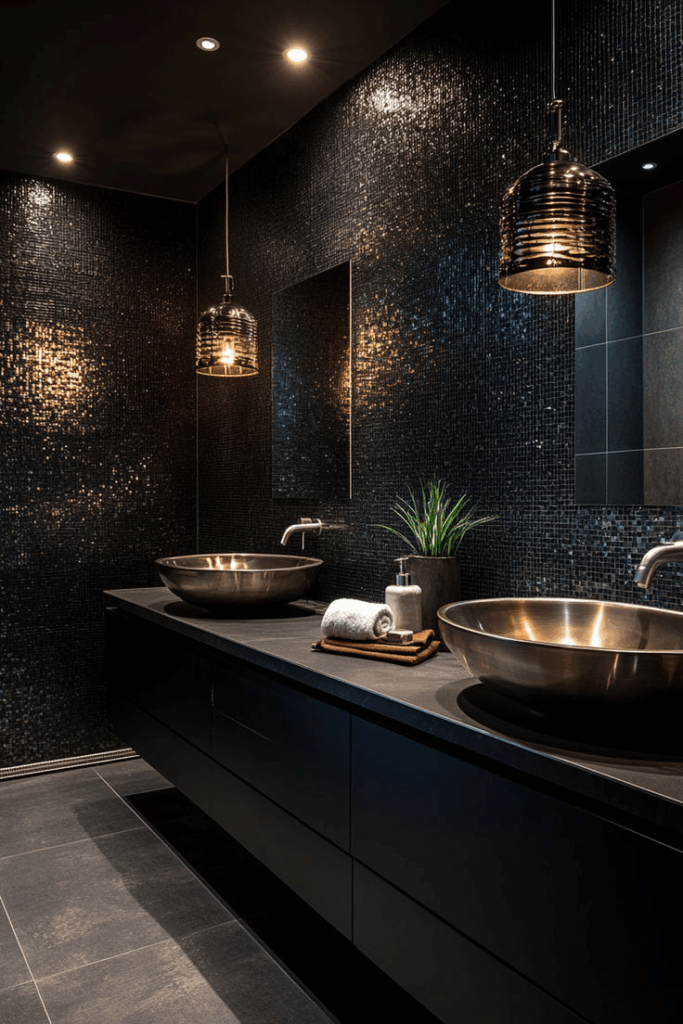
Paring back decor to essentials enhances the impact of mood and material in compact powder rooms. Clean lines, uncluttered surfaces, and intentional negative space allow rich finishes and bold accents to breathe. Rather than filling every inch with decor, this approach focuses on selecting fewer but more impactful pieces. A single sculptural vase, a framed abstract piece, or a textural wall sconce becomes a focal point. Neutral accessories in deep shades—like charcoal soap dispensers or matte black trays—contribute to the ambiance without adding noise. Storage remains hidden or discreet, emphasizing a tidy, serene visual flow. Even toilet paper holders and hardware are selected for form and finish, not just function. By simplifying the environment, the emphasis shifts to atmosphere and detail. This style works exceptionally well with moody tones, allowing the drama of the palette to take center stage in a serene, artful way.
High-Contrast Accents
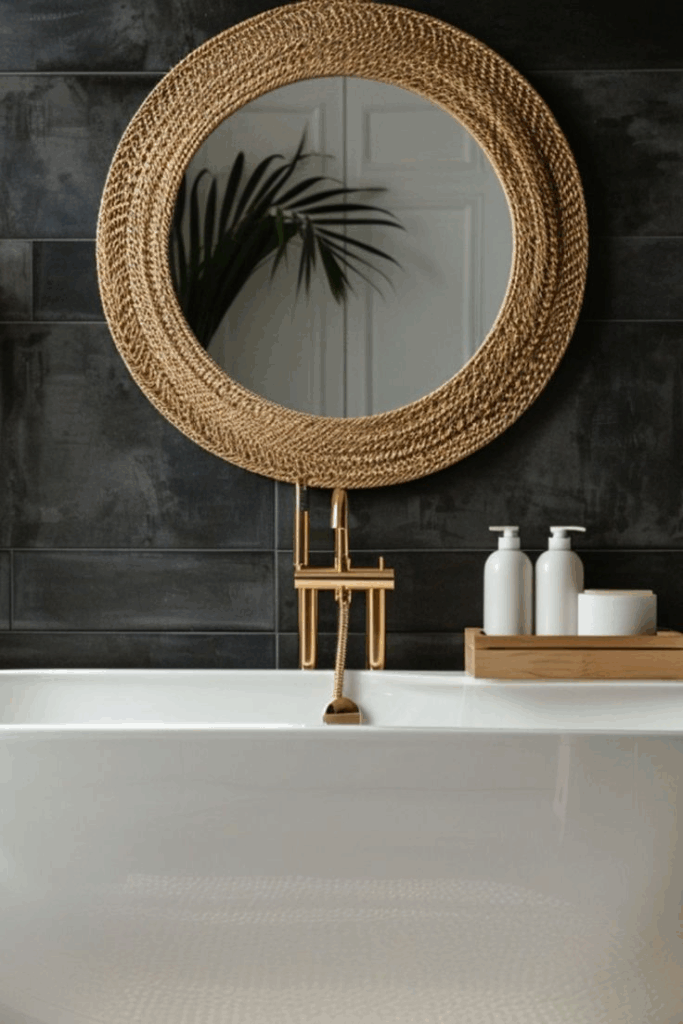
Striking contrast injects visual energy into moody powder rooms without overwhelming their cozy charm. Using dark walls as a backdrop, consider crisp white basins, brass fixtures, or glossy tiles to draw the eye and create dimension. This interplay of light and shadow makes each element feel deliberate. Contrast can also be achieved through materials—soft linens against sleek marble, rough wood beside polished metal. High-contrast doesn’t have to mean stark; even tonal differences within the same color family can offer subtle drama. Integrating reflective surfaces like mirrors or glass shelves enhances light distribution and adds a layer of sophistication. This tactic works especially well in small spaces, where every detail plays a larger visual role. Rather than crowding the room with decor, let the interplay of opposing finishes and shades set the mood. Done right, contrast adds movement, elegance, and clarity to even the darkest powder room palette.
Ceiling Treatments
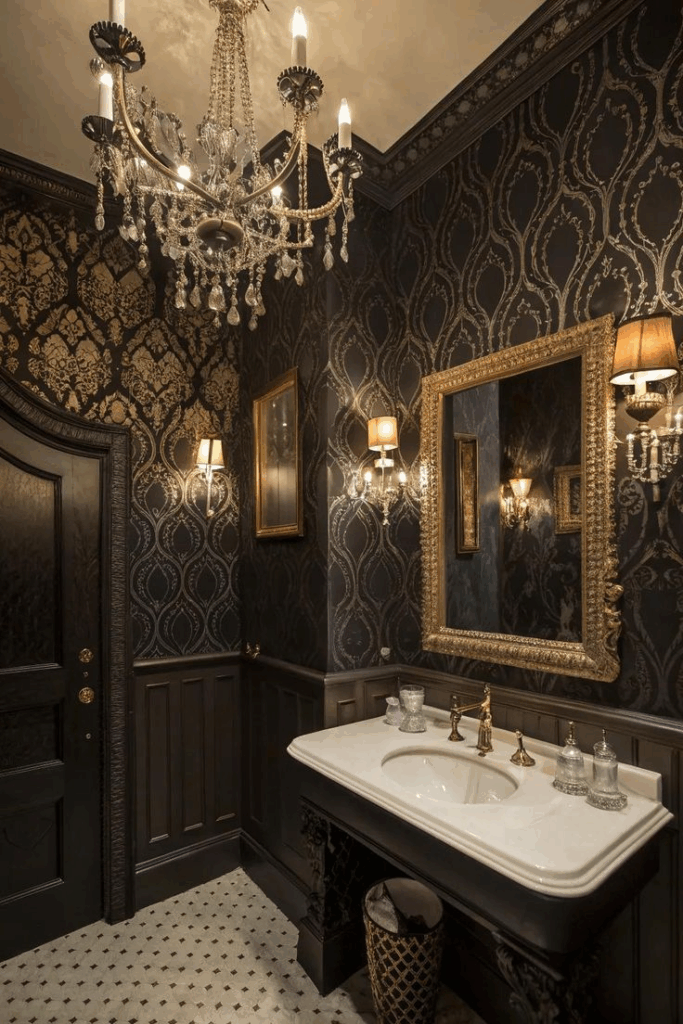
Often overlooked, the ceiling offers untapped design potential in a moody powder room. Whether painted in a matching dark tone or finished with wallpaper, it draws the eye upward and adds surprise to a compact space. Beadboard, tongue-and-groove panels, or coffered designs introduce subtle texture while maintaining a cohesive theme. For a dramatic touch, consider a metallic sheen or deep matte hue that mirrors the room’s palette. Lighting plays a role here, too—pendants or flush mounts can highlight the ceiling and reflect the moody ambiance. This detail works especially well in windowless powder rooms where every surface counts. By treating the ceiling with as much care as the walls, the room feels enveloping and polished. It’s not just about adding decor overhead; it’s about completing the space visually. A thoughtfully designed ceiling contributes to a holistic, immersive experience that makes the powder room truly stand out.
Customized Storage
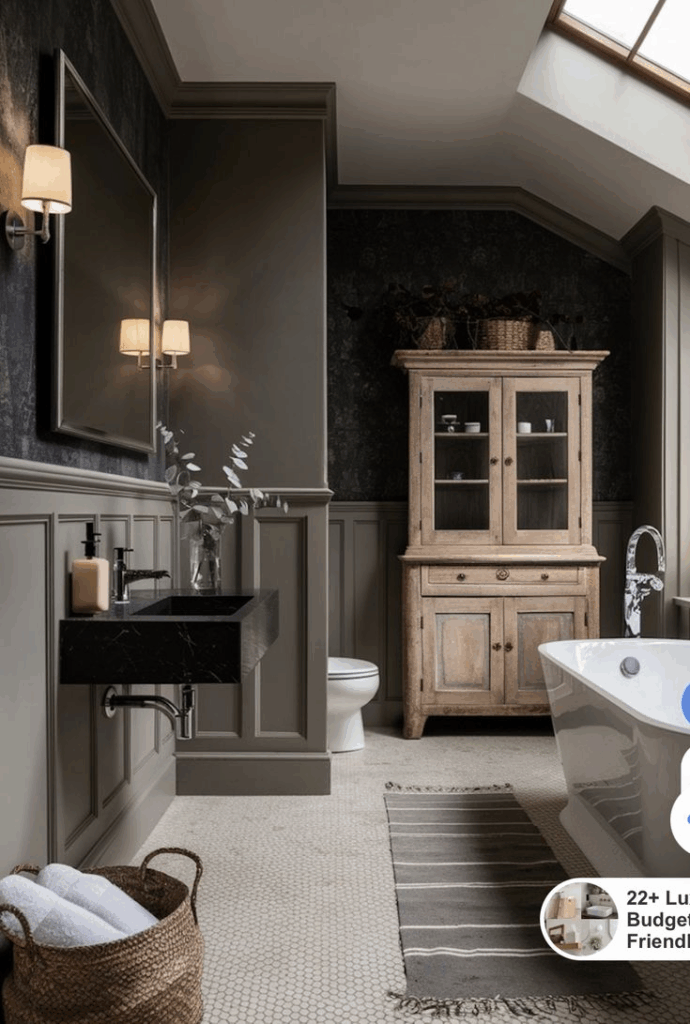
Tailored storage solutions help maintain visual flow without disrupting the moody aesthetic. Built-in niches, floating shelves in matching tones, or hidden cabinetry ensure essentials remain accessible yet unseen. Use wood, metal, or painted finishes that align with the rest of the palette. Opt for drawers with soft-close mechanisms, push-to-open panels, or recessed compartments for a clean silhouette. Consider alcoves in tiled walls or vanity sides to store hand towels and toiletries in a clutter-free manner. Open shelving works when paired with curated decor—glass jars, vintage perfume bottles, or textured boxes that contribute to the ambiance. In small powder rooms, multifunctional storage that blends into the wall keeps the mood intact. Even baskets tucked beneath vanities or slimline cabinets behind mirrors can add functionality without sacrificing design. Ultimately, customized storage maintains the space’s clean lines while offering practicality—ensuring that the room stays as usable as it is beautiful.
